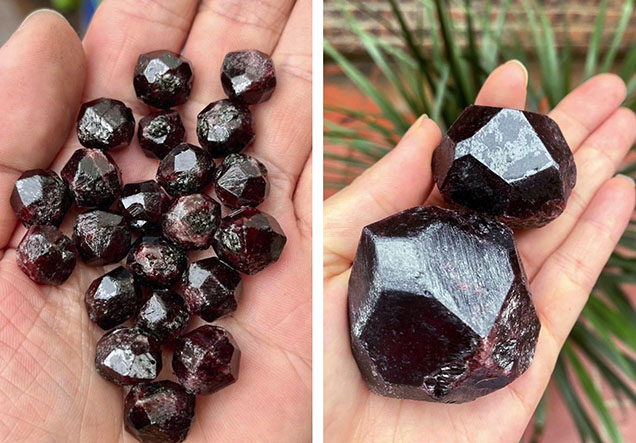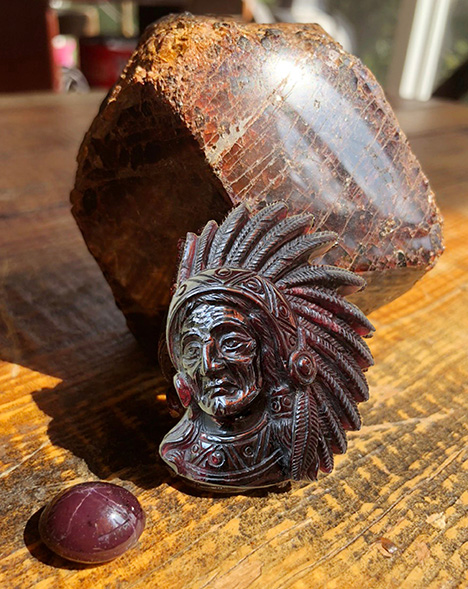Almandine Garnet from Phu Tho, Vietnam

During the early 2000s, garnet was discovered and mined along with black tourmaline and aquamarine in the northern Vietnamese province of Phu Tho. Its undesirable appearance led to a suspension of mining activities, but mining resumed in 2021 with more promising results. Phu Tho borders the province of Yen Bai, which has produced a wide range of gem materials such as ruby, sapphire, spinel, and tourmaline. Despite their proximity, the geological settings are much different, and Phu Tho produces tourmaline, beryl, and garnet.
Rough garnet from Phu Tho possesses typical cubic crystal shapes with either trapezohedral or elongated habit. The authors purchased a total of 28 samples, including 26 euhedral trapezohedral crystals (figure 1) and two enormous rough samples, from a garnet miner in Phu Tho. One crystal was cut into a cabochon measuring 17.23 × 14.82 × 9.37 mm and weighing 24.30 ct. The other 25 crystals were kept intact, ranging from 11 to 29 mm with a total weight of 218.58 g. The two large samples were elongated and up to 30 cm in length. Most of the garnet is found in black mica schist. Although the materials formed within the host rock, the crystals can be detached easily into loose crystals. The Phu Tho garnet displays colors from medium dark to very dark red to purple-red. Its transparency ranges from translucent to opaque, with no transparent material found, and the luster is vitreous to greasy.
Standard gemological testing of the samples showed a refractive index of 1.78 to over the limit of the refractometer, specific gravity ranging from 4.01 to 4.12, an almandine spectrum, and an inert reaction under ultraviolet light (long-wave and short-wave). Microscopic examination revealed several solid black inclusions and oriented needles of rutile, some fingerprints, and feathers filled with iron stains. These results confirmed almandine garnet. Raman spectroscopy showed distinct peaks at 123 and 1456 cm−1, consistent with almandine.

Because of their dark tone and low transparency, Phu Tho garnets are more suitable for cutting as cabochons, beads, and ornamental carvings (figure 2). Asterism was observed in several samples from Phu Tho, with four- or six-rayed stars caused by oriented rutile needles intersecting at angles of 120° and 60°. Interestingly, the occurrence of both four- and six-rayed stars within a polished sample is not rare. In the studied samples, we counted a maximum of five six-rayed stars and two four-rayed stars on one side of a garnet. The display of multiple stars within garnet was previously reported by K. Schmetzer et al. (“Star garnets and star garnet cat’s-eyes from Ambatondrazaka, Madagascar,” Journal of Gemmology, Vol. 28, No. 1, 2002, pp. 13–24), and so far this phenomenon has only been found in garnet.
Although most Phu Tho garnet is not suitable for high-quality jewelry making, giant crystals or well-formed crystals on host rock could be valuable as ornamental objects or mineral specimens.



